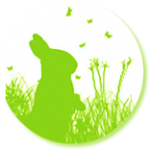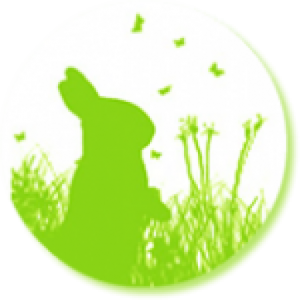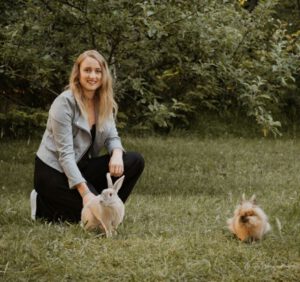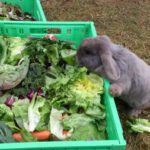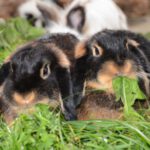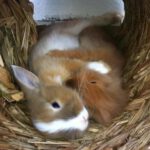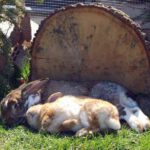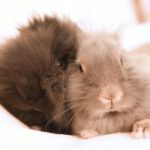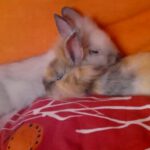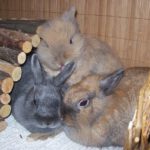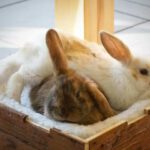„My rabbit is nibbling on itself or a partner rabbit in a specific spot, pulling out fur, and/or licking and biting the area until it bleeds.“

Trichophagy (fur pulling), „shaving,“ excessive grooming, overgrooming, barbering, and wound licking by companions as a behavioral disorder
This behavior is a behavioral disorder that can have various causes. In addition to identifying the underlying cause, a veterinarian should always be consulted. It can lead to fur loss/bald spots, sore areas, or even bleeding wounds. These areas are also referred to as lick granulomas.
Common causes include:
Lack of Chewing Opportunities
This behavior occurs noticeably often, or almost exclusively, in indoor housing (see behavioral disorders in indoor housing). In nature, rabbits constantly nibble and graze on grass, which is missing as a natural substrate indoors.
To compensate, it’s important to fully cover the enclosure floor with bedding (e.g., by pulling the PVC flooring up at the edges and layering bedding with a thick layer of straw on top). Additionally, provide multiple piles of straw and scattered fresh food (greens, hay, and fresh branches).
Incorporate natural materials into the living space: tree trunks, branches, leaves, roots, straw, meadow plants, potted plants, chew materials, straw and hay baskets… Keep things interesting by introducing new items daily, rearranging existing ones, and replacing old materials regularly.
It can help to offer fresh, fiber-rich food (hay, grasses, wild plants, branches) several times a day and place it in different spots throughout the enclosure.
Frustration Due to Fundamentally Incorrect Housing (Too Little Space, No Free Roaming, Lack of Enrichment and Stimulation)
Rabbits exhibiting this behavior should have at least 8m² of space available day and night and be provided with plenty of variety and enrichment. They should never experience boredom if possible.

Frustration Due to Lack of a Social Companion (Single Housing)
Rabbits are highly social animals, and keeping them alone does not meet their needs, potentially leading to behavioral issues. It’s important to understand that true incompatibility between rabbits is rare; such problems are usually the result of mistakes in the bonding process, improper partner selection, or separating them too soon. We strongly recommend educating yourself on the correct way to bond rabbits.
Frustration Due to Sexual Drive
This issue occurs in both unneutered males and females. When the sexual drive cannot be expressed, they may engage in substitute behaviors. Neutering can resolve this problem.

Stress (Due to Various Factors)
Stress of any kind can trigger such behavior. Stressors can include an unharmonious group, significant changes in the environment, the loss of a companion, etc. Heat cycles in females or false pregnancies can also be strong triggers of stress. In the photo on the right, the cause is the heat cycle of a female rabbit.
Nesting Behavior
Many rabbits also pull fur from their partner’s sides to use it for nesting (during heat, false pregnancy, or actual pregnancy).

Itching
Itching caused by mites, lice, allergies, medication reactions, fungi, or other parasites can lead to self-inflicted damage in the affected area. The rabbit scratches and bites itself until it bleeds, chews on its fur, and tries to relieve the itching in any way possible.
Eye Discharge
Eye discharge is often lovingly licked away by the partner rabbit and may go unnoticed. However, due to the discharge and constant grooming, it can lead to bald spots and lick granulomas, as shown in the image on the right.
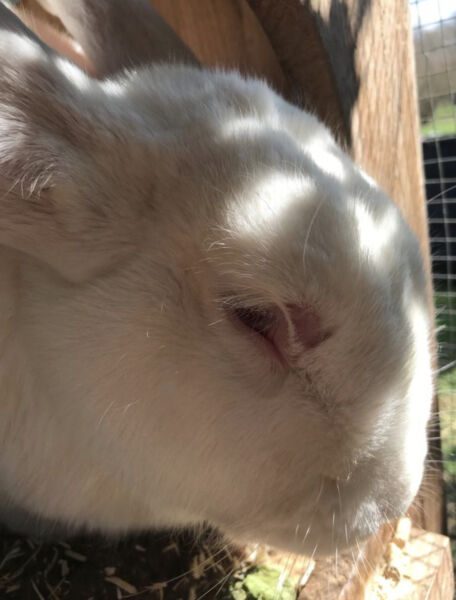
Other Illnesses
There are many diseases related to self-mutilation or mutilation by others. For example, a rabbit with dental misalignments that drools may injure itself while grooming the wet fur on its chin. Conditions that cause pain can lead to self-inflicted injuries. With worm infestations, rabbits often chew on their fur. If a rabbit experiences pain in a certain area, it may gnaw and lick that spot intensively. For instance, rabbits with arthritis may chew the inner thighs bald when they experience severe pain (as seen in the photos).
Incorrect Feeding
A diet that is too low in fiber can lead rabbits to chew on their own or others‘ fur. If sufficient stimulation is not provided through food, it can result in boredom, which then reinforces such behavior. In these cases, food-related activities, such as scattered, varied, diverse, and hidden food, are essential. It’s important to remember that, in the wild, rabbits primarily engage in grazing, nibbling, and foraging. Providing multiple bins scattered around the living space with straw, leaves, soil, hay, grass, and fresh kitchen herbs in pots, as well as generously bedding areas with straw and small animal bedding, can help. Also, widely distributing food in various hay racks is beneficial
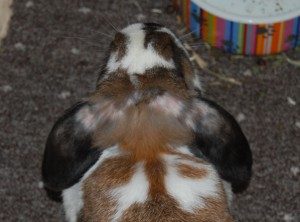
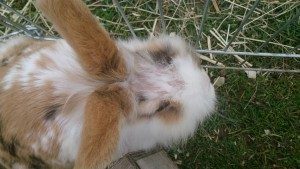
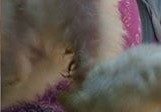
The cause should be urgently identified and addressed. In mild cases, even a heat cycle can lead to nibbling on a partner, and this behavior will subside once the heat cycle is over.
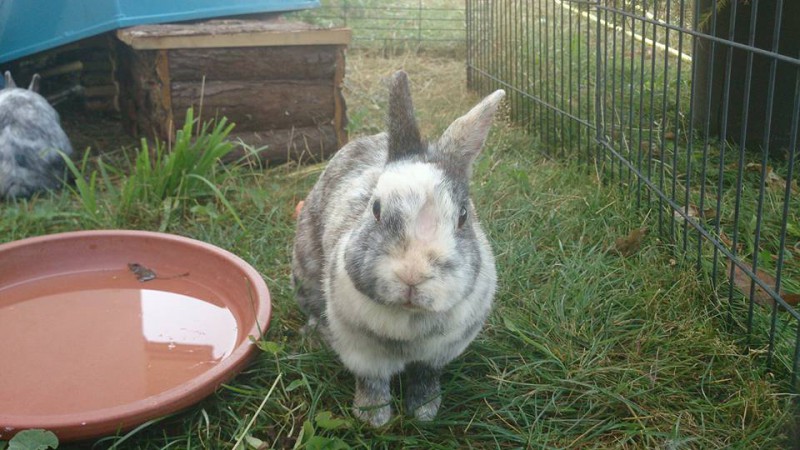
If physical causes such as mites or fungi are ruled out (these can also occur in areas that are being chewed) and your own efforts are not sufficiently resolving the behavior, a veterinarian specializing in behavioral therapy with a focus on rabbits/small mammals can help. Alternatively, you can book a behavioral therapy consultation through our advisory service. It would be ideal to provide photos of the affected areas, information on what you have already tried and whether it helped, as well as photos of the feeding areas and living space so I can best assist your rabbit!
Sources include:
Berthelsen, H., & Hansen, L. T. (1999). The effect of hay on the behaviour of caged rabbits (Oryctolagus cuniculus). Animal Welfare, 8(2), 149-157.
Döring D, Erhard M H. (2015): Verhaltensprobleme bei Kaninchen. kleintier konkret 18(S01): 2 – 6
